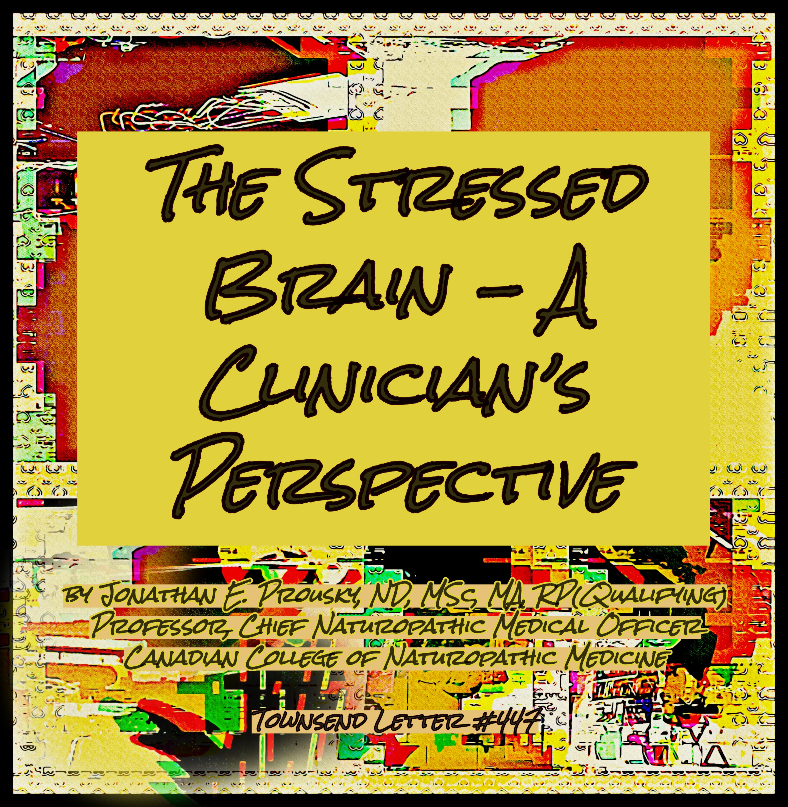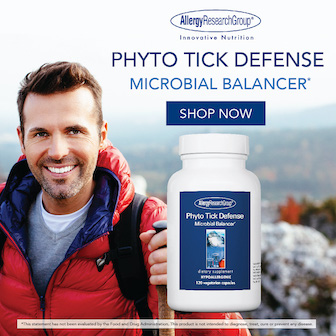Jonathan E. Prousky, ND, MSc, MA, RP(Qualifying)
Professor, Chief Naturopathic Medical Officer
Canadian College of Naturopathic Medicine
Abstract
This two-part series focuses on integrative treatments that can bring improved regulation to the stressed brain. Concepts from stress research, i.e., allostasis, allostatic load, and allostatic overload, are defined and referred to within the article’s chronic stress framework so as to enumerate treatments that mobilize allostatic systems to improve brain and psychological health, as well as physical health. The treatments advocated include natural health products to lower the intensity of emotional overwhelm and to reduce the pathophysiological harms to the brain and body. Other recommended treatments include diet, exercise, nature, meditation, sleep, the avoidance of substances, psychotherapy and/or social support, as well as an assortment of psychological and behavioral recommendations. The integrative approaches, such as those mentioned in this article, should serve as models of the kinds of interventions that can realistically and dramatically affect the course of chronic stress and prevalent medical diseases via allostatic brain mechanisms.
Introduction
When the brain is stressed, the limbic system (i.e, includes the amygdala, hippocampus and other brain structures) seems to dominate the prefrontal cortex (PFC). A functional disconnection between these brain areas ensue, such that the PFC cannot effectively modulate emotions and attenuate the resulting stress response.1 When this becomes an enduring problem, as happens from chronic stress, many pathophysiological impacts result, including mental morbidity, psychiatric illness, and medical disease (Table 1, below, provides an explanation of the common terms used in this paper).1
Given the inherent challenges to working with chronically stressed patients, it is imperative that treatment aims to restore their biological regulation. First, a thorough clinical evaluation needs to be done to rule-out diseases that would continue to wreak havoc unless properly treated. Then, various therapeutic interventions should be used to mitigate the psychological and physical harms accrued from being chronically stressed. This article will describe numerous integrative treatments that target allostatic mechanisms within the brain, and also other physiological systems when needed, to increase patients’ quality of life (i.e., healthspan), and maybe even longevity (i.e., lifespan).
Table 1 Definitions
Allostasis: Coined by Sterling and Eyer,2 refers to biological adjustments that allow an individual to adapt to particular challenges that happen over the lifespan. Adapting to such challenges demands the synchronous though non-linear activation of many different physiological processes, such as neural, neuroendocrine, and neuroendocrine-immune mechanisms.3 Allostasis begins with the brain and happens or is instigated by how an individual perceives and interprets any given situation. Allostasis is about adaptation, but the physiological adaptations may not ensure survival because they can become deleterious over time and cause irreversible damage.
Homeostasis: Is about ensuring survival, and refers to “physiological parameters like blood oxygen and pH” that are “maintained within a narrow range” (p.37).3
Chronic stress: Defined as “ongoing demands that threaten to exceed the resources of an individual in areas of life such as family, marriage, parenting, work, health, housing, and finances,” p.638).4 In physiological terms, chronic stress refers to a “pathological state that is caused by prolonged activation of the normal acute physiological stress response, which can wreak havoc on immune, metabolic, and cardiovascular systems” (p.56).5 When an individual is faced with chronic stress, which is common among most psychologically distressed patients, it may seem enduring and without a clear ending.
Allostatic load (AL), and allostatic overload (AO): AL represents body degradation that results from repeated allostatic responses during stressful situations.6 This results when an allostatic system fails to habituate to the recurrence of the same stressor, fails to shut off following overwhelming stress, and/or whose response is deficient resulting in heightened activation of other, normal counter-regulatory systems.3,7 AO is thus an extension of AL, which often results in irreversible damage to body organ systems, and/or mental illness. Thus, unmitigated chronic stress that results in AL and AO will typically cause all sorts of psychological distress signals, especially among individuals vulnerable to mental illness.
Using Natural Health Products to Lessen the Impacts of Chronic Stress
The conventional approach involves pharmaceutical intervention, which can be extremely helpful and potentially lifesaving. In their article discussing stress- and allostasis-induced brain plasticity, McEwen and Gianaro stated the following in reference to pharmaceutical interventions:
Sleeping pills, anxiolytics, beta blockers, and antidepressants are all used to counteract problems associated with allostatic overload. Likewise, drugs that reduce oxidative stress or inflammation, block cholesterol synthesis or absorption, and treat insulin resistance or chronic pain can help deal with the metabolic and neurological consequences of chronically stressful experiences. All of these agents have value, but each one has side effects and limitations that are based in part on the fact that all of the systems that are dysregulated in allostatic overload interact with each other and perform normal functions when properly regulated (pp.439-440).8
Similar to pharmaceutical interventions, natural health products (NHPs) can be used to attenuate AL and AO. They are often of great importance to patients because they typically possess fewer adverse effects compared to pharmaceutical interventions. Many NHPs can be safely integrated with standard approaches or can sometimes be used as an alternative. NHPs can be used to modulate the activity of the PFC and/or limbic system to presumably improve the functional connection of these brain circuits, thereby, assisting the PFC with improved top-down control and processing, and/or attenuating limbic activity to dampen bottom-up control. NHPs can also mitigate pathophysiological harms from AL and AO, such as high blood pressure, insulin resistance, and other medical problems.
Information known about pharmaceutical interventions can be extremely helpful when postulating how NHPs assist with improving PFC and limbic functionality and connectivity. The essential aim of a modern treatment strategy is to deconstruct the psychiatric illness in question, then consider a treatment or set of treatments that hypothetically improves or attenuates malfunctioning neurocircuitry by targeting specific neurotransmitters in that circuit, which then relieves symptoms and improves overall functionality.9 Antidepressant medications are good examples of pharmaceutical interventions that possess specific pharmacological effects to modulate implicated neurocircuits. They can increase the availability of serotonin and other monoamines between the synapses of neurons. The release of serotonin at target neurons, for example, activates receptors that are widely expressed in the hippocampus, amygdala, and PFC, and which mediate fear, anxiety, stress, and cognitive function.10
Antidepressants also increase brain-derived neurotrophic factor (BDNF) expression, which is believed to be responsible for the time lag prior to an antidepressant response, since it takes several weeks for the pharmacological actions to augment the expression of BDNF.11 Antidepressants may help to compensate for the levels of BDNF in specific brain areas (i.e., the PFC and hippocampus) that are presumed to be insufficient as a consequence of chronic stress.11







